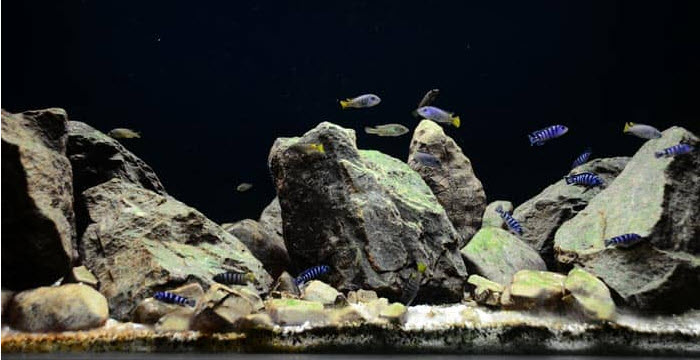
Summary of Rock Data
ALL rocks and stones you will find in your rock yard, yard, or the local stream are fine just as is (i.e. no boiling or bleach), including those that bubble with acids like vinegar. Shells and corals are also perfectly safe with no treatment as are almost all gemstones, semi-precious stones, tumbled rocks, geodes, crystals, bones, and antlers.
There are a huge number of very firmly held myths about rocks that just are not true. For instance, there are virtually NO rocks gems, geodes, polished stones, or crystals that are damaging to fish in any way. There are a few rare minerals found deep inside mines that are poisonous but that is hardly a concern. Only avoid malachite and azurite as they can be toxic in some aquariums.
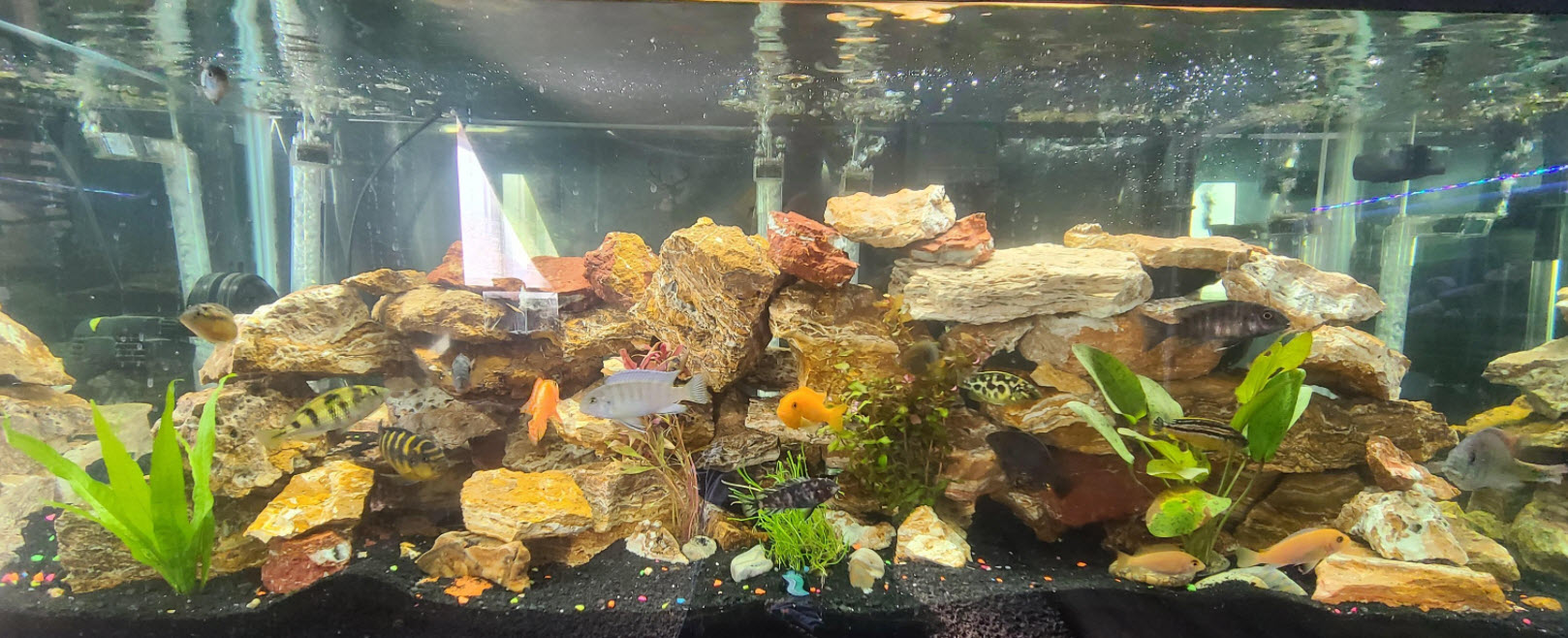
Any form of calcium carbonate (“bubbles in vinegar”, limestone, coral rock, shells) can slowly raise the pH of the aquarium to 7.6 to 7.9 pH, no higher. This is a great pH for all adult fish. The only concern might be that there are a few species of blackwater fish that will not spawn in this water.
And it violates several laws of physics for a BOILED rock to “explode” (all the YouTube videos are of rocks in a FIRE PIT that explodes, a quite common occurrence). That being said, since any fish you add will have a million times more fish pathogens on its body than any rock can have, and you can’t sterilize a fish, it is kind of useless to boil or heat a rock.
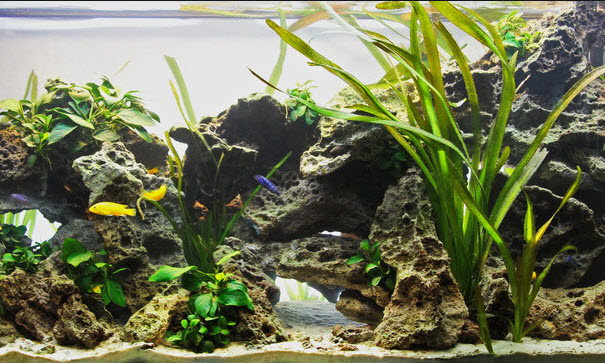
Just a Little Common Sense
What is amazing here is that if you show a pile of various rocks on social media EVERYONE and I mean EVERYONE will give you a long list of minerals to avoid. And each list will be different. And every single list will be WRONG!
Note that saying this on social media will invariably get some response from a “know-it-all nitpicker” like “What about azurite and malachite, they’re poisonous?” Azurite and malachite are minerals found deep inside copper mines and are prized by mineral collectors. The chances of finding azurite or malachite lying about are about the same as the chances of being hit and killed by a meteorite. I do recommend that if you have pieces of malachite or azurite you do NOT use them in your aquarium.
Other very rare poisonous minerals found only in a few mines are ulexite, borax, realgar, and orpiment. Note that other minerals like sulfur, fluorite, vanadinite, and cinnabar not only are very rare and aren’t found on the surface, but they also aren’t poisonous.
And as for poisonous explosive residue on rocks, if the rocks were quarried with explosives they will have parts per billion of water-soluble, easily degraded, nontoxic explosives on them till the first rainstorm.
The same goes for coral or marine “live rock” which might have had a very rare and exotic type of poisonous coral on it (some Zoanthid coral species contain palytoxin poison). As far as we can determine, there has never been a single case of palytoxin poisoning of fish in the aquarium hobby. It is just theoretically possible. You have a far better chance of winning millions in the lottery than killing your aquarium fish with toxic coral residue.
But then the doomsday folks will say “better safe than sorry”. Concern over our pets is important, but listening to this type of worrying will just suck all the enjoyment out of the hobby
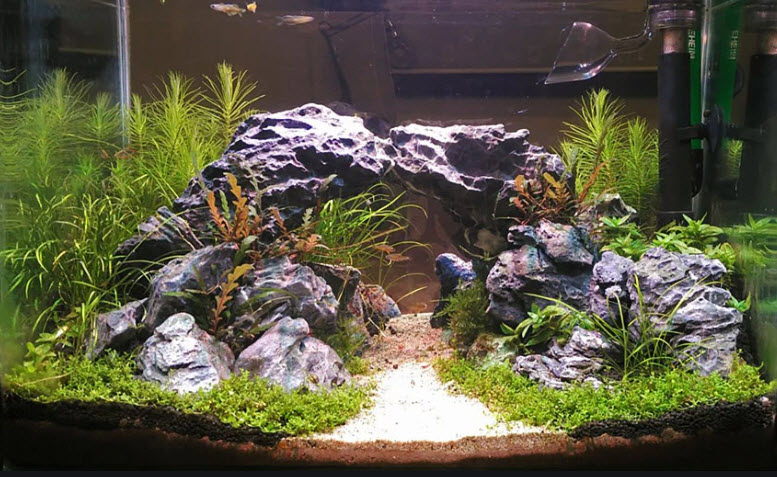
Isn’t it interesting that streams tumble over all sorts of rocks, including ones that fizz, geodes, and crystals, yet the fish aren’t somehow poisoned or affected in any way? And our well water, which has percolated through all sorts of rocks, isn’t poisonous. Of all the billions of wells, ponds, lakes, streams, and waterways in the world there are only a few streams that drain man-made things like industrial waste or mine waste which are in any way poisonous to fish. Yet everyone and their uncle will keep telling us to be careful about all that poisonous rock out there in nature.
And then there are the folks that come on social media with comments like “I added two rocks to my aquarium and the next day all the fish were dead“. There is an old saying in science, “correlation is not causation”. The person, as is typical, added two new rocks when they did a water change. The water had been “chlorine pulsed” by the water supplier (a very common occurrence!), overwhelming the conditioner used. And the chlorine killed the fish. And a myth is born.
Note that “store-bought rocks” can have a small problem. Sometimes manufacturers coat the rock with mineral oil to make them more attractive. Mineral oil won’t kill fish but it can interfere with aeration in the aquarium.
So if you buy a colorful rock in your fish store, test the rock by putting a drop of water on the rock. The water should wet the rock. If the drop makes a round bead, you have oiled rock and it will need to be cleaned with some detergent in water. Just make sure to rinse it well as the detergent is worse than the oil when it comes to toxicity to the fish.
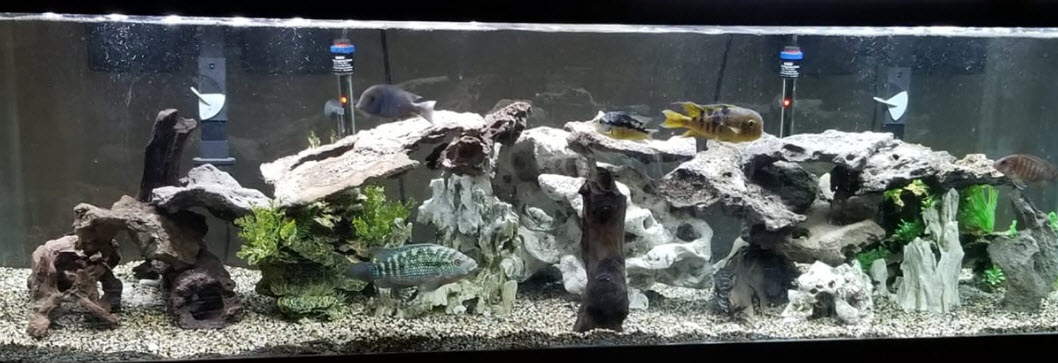
Myths in Depth
Rocks probably have more parroted “myths” repeated about them than any other aquarium subject. Note that this article started with about five “myths”. But then the “myths” about rocks just kept coming. We’re now up to 25 myths. You’ll forgive me if I sound a little exasperated: these seemingly ineradicable myths cause hobbyists so much unnecessary worry.
Let me put all of them to rest with a very lengthy, boring, verbose article that will only interest the hobbyists who are complete nerds, like myself. This verbosity is due to the difficulty in proving a negative.
We heartily recommend just skipping down to the particular myth one is interested in.
- Myth #1 The “Vinegar Test” Indicates “Bad” Rocks
- Myth #2 There are a Lot of Poisonous Common Minerals
- Myth #3 Lots of Gemstones and Semi-precious Stones are Poisonous
- Myth #4 Crystals and Geodes are Poisonous
- Myth #5 “Sparkles” and Iron are Poisonous
- Myth #6 Heavy Metals will Leach Out and Kill Fish
- Myth #7 Metals are Poisonous in an Aquarium
- Myth #8 Sharp Rocks can Cut the Fish
- Myth #9 Insecticides and Herbicides are a Problem on Rocks
- Myth #10 It is Necessary to Boil or Bleach Rocks
- Myth #11 Boiling Rocks can Explode
- Myth #12 Sandstone will Fall Apart in the Aquarium
- Myth #13 Porous Rocks Must be Cleaned with Detergents
- Myth #14 Green Rocks are Dangerous
- Myth #15 Shales Need to Be Avoided
- Myth #16 Shells Need to be Coated
- Myth # 17 Bone and Antlers will Decompose if not Coated
- Myth #18 Be Careful of Radioactive Rocks
- Myth #19 Rocks from the Seashore Contain too Much Salt
- Myth #20 Avoid High Silica Rocks like Quartz to Prevent Brown Algae
- Myth #21 Pathogenic Protists will be Found on Sedimentary Rocks
- Myth #22 Lava Rock is Bad As It can Contain Sulfides and Carbonates
- Myth #23 Fresh Lava is Poisonous
- Myth #24 Lava Rock Decomposes Nitrate
- Myth #25 Some rocks have cleaning chemicals from dry cleaners on them
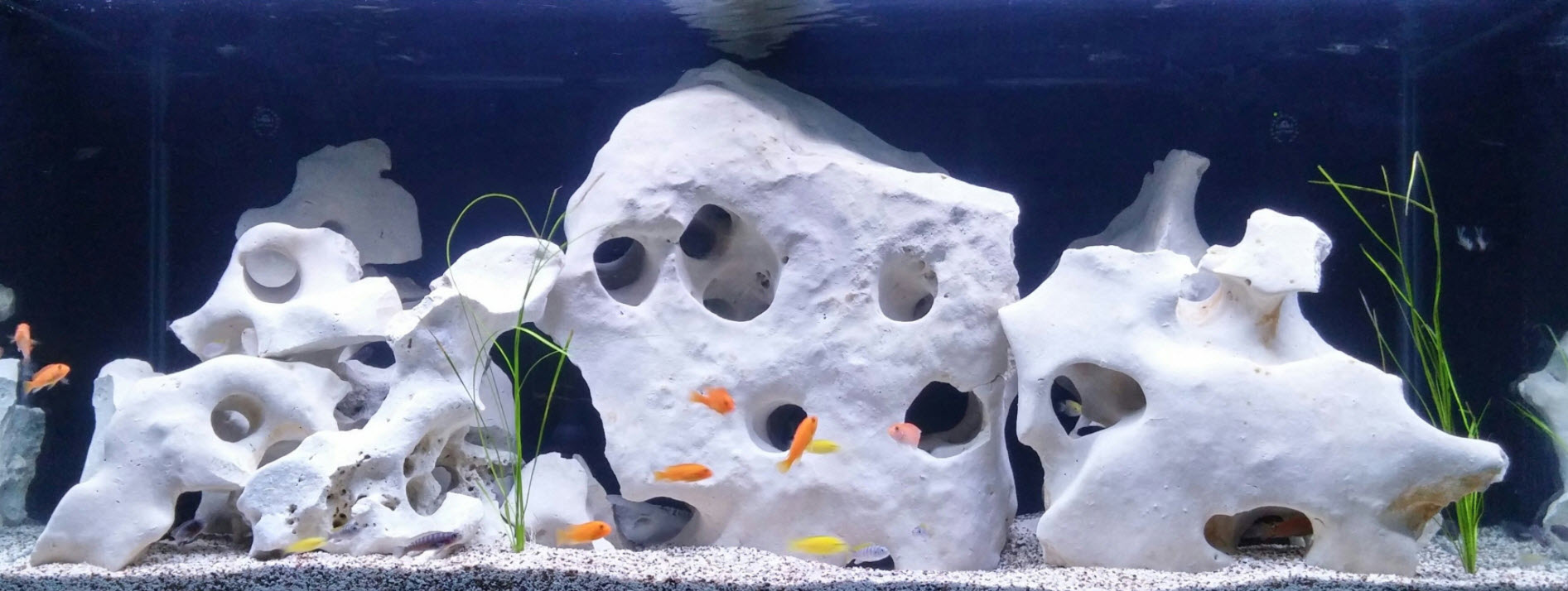
Myth #1 The “Vinegar Test” Indicates “Bad” Rocks
Most aquarium owners know the “fact” that if you drop vinegar on a rock and it bubbles, the rock can’t be used in the aquarium. This “fact” is simply wrong. Very wrong.
First off the “vinegar test” doesn’t work, period. If drops of vinegar are put on a rock that is calcium carbonate, the vinegar is too weak of acid to “fizz” and bubble. Small bubbles will form with vinegar only very slowly when the rock is immersed in vinegar. You need to hit the rock with drops of a more concentrated acid such as hydrochloric acid (pool acid).
If a rock bubbles when hit with mineral acid it is the chemical compound calcium carbonate. Seashells, coral, Seiryu Stone, cuttlebone (“cuttlestone”), aragonite, limestone, travertine, calcite, marble, tufa, coquina, chalk, and holey rock are all calcium carbonate. Any form of calcium carbonate dissolves a very small amount in water with a pH below 7.6 to 7.9. to create water that is only 7.6 to 7.9 pH, no higher.
Whole mountain ranges on earth are composed of calcium carbonate in the form of limestone. The mountain ranges dissolve extremely slowly in carbon dioxide-filled water, forming caverns over millions of years. If calcium carbonate dissolved more than the tiny amount that gives a pH of 7.6 to 7.9, these mountain ranges would have dissolved away millions of years ago.
So any water with a pH of below 7.6 to 7.9 will be buffered to 7.6 to 7.9 pH and only up to 7.6 to 7.9 pH by any form of calcium carbonate (the pH is never dropped by calcium carbonate).
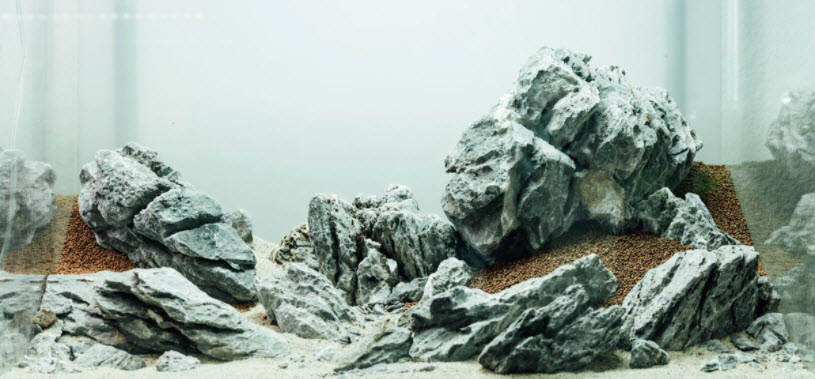
What non-chemists understandably have difficulty wrapping their heads around is how pH is affected when there is something called an “equilibrium” setup. The calcium carbonate heads towards equilibrium with the salts in the water. This equilibrium in water goes to an extremely low calcium carbonate concentration which will produce a buffered 7.6 to 7.9 pH, no higher.
If the water is very pure and free of salts the equilibrium will proceed faster to a higher number. If the water has some salt content the equilibrium will proceed slower to a lower number.
Tests that were run on limestone rocks, coral, and shells confirmed this equilibrium. These tests can be found at the following link:
14.2.3. Buffering Substrates
Since a pH of 7.6 to 7.9 is a very good pH for any tropical freshwater fish these materials are good for fish, not bad for fish. Now many will take issue with the comment that “7.6 to 7.9 is a very good pH for any tropical freshwater fish” but it is simply true. The reasoning behind that mythbuster is explained at length in this link:
4.4.1. pH is not Important
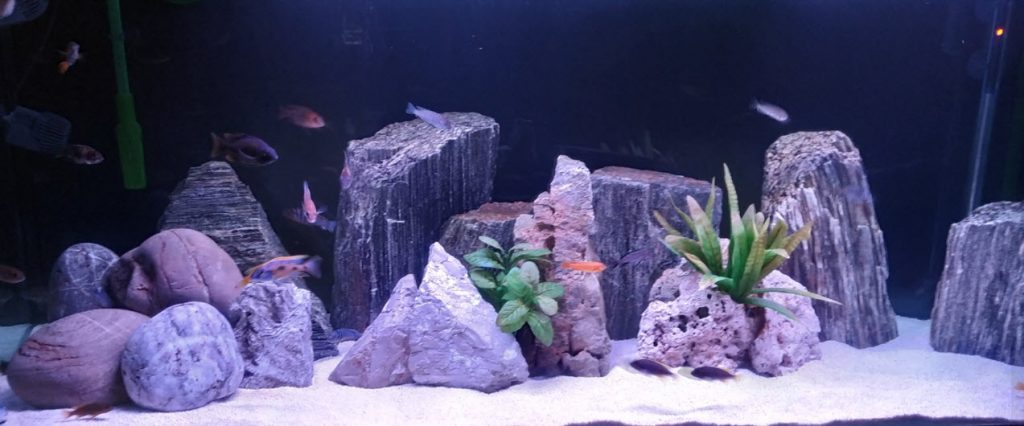
When the calcium carbonate dissolves a little bit and buffers the water it raises the GH (“Hardness”). GH (“general hardness” or “total hardness”) is just the amount of calcium and magnesium in the water. This is the white crap that builds up at the waterline of aquariums. GH is unimportant for ALL adult fish and most fry. Just keep the pH between 6.5 and 8.5 and the total dissolved solids above 50 (i.e. all water except distilled and RO) and all adult fish do fine. GH and pH only become important in breeding a few species of fish. This mythbuster is discussed at length in this link:
4.5.1. General Hardness
Now if you are trying to create an acid blackwater biotope for realism you don’t want to add rocks that are calcium carbonate. But the calcium carbonate won’t hurt the fish that come from blackwater environments. Calcium carbonate will not change the appearance of a blackwater tank and won’t affect the brown material one uses for coloration, whether that be tannic acid or peat acids.
Note that the dissolution rate of the calcium carbonate rock is closely related to the surface area and the water flows over that area. A bag of crushed coral inside a filter will raise the pH to 7.5 in a matter of days. A chunk of holey rock in relatively still water in the aquarium might take months to raise the pH to 7.5.
Note that there are no rocks or minerals which will significantly acidify alkaline water. And if you add a calcium carbonate rock to high pH water, like more than 8.4 pH, the rock will not affect the pH at all.
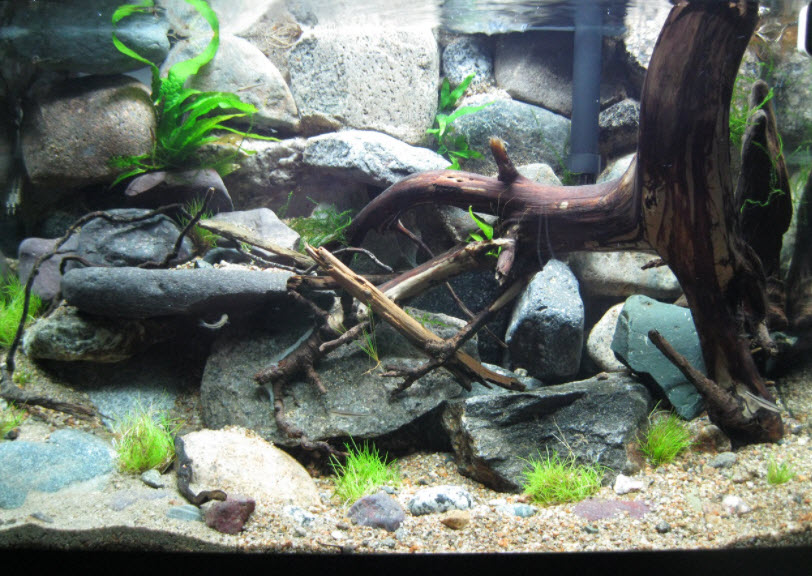
Myth #2 There are a Lot of Poisonous Common Minerals
Aquarium Wiki website says to avoid; limestone, coral, amethyst, geodes, gypsum, ironstone, nephrite, marble, jasper types, sandstone, and feldspar as they are poisonous. This is just incredibly wrong! For instance, easily 75% of the rocks on earth have feldspar in one form or another in them. So if feldspar were poisonous all water on earth would be deadly. Sandstone is SAND, the same sand one uses as a substrate in an aquarium! All of these minerals and rocks are perfectly safe and fine to use in the aquarium.
Here are two other lists commonly put up on Facebook aquarium forums:
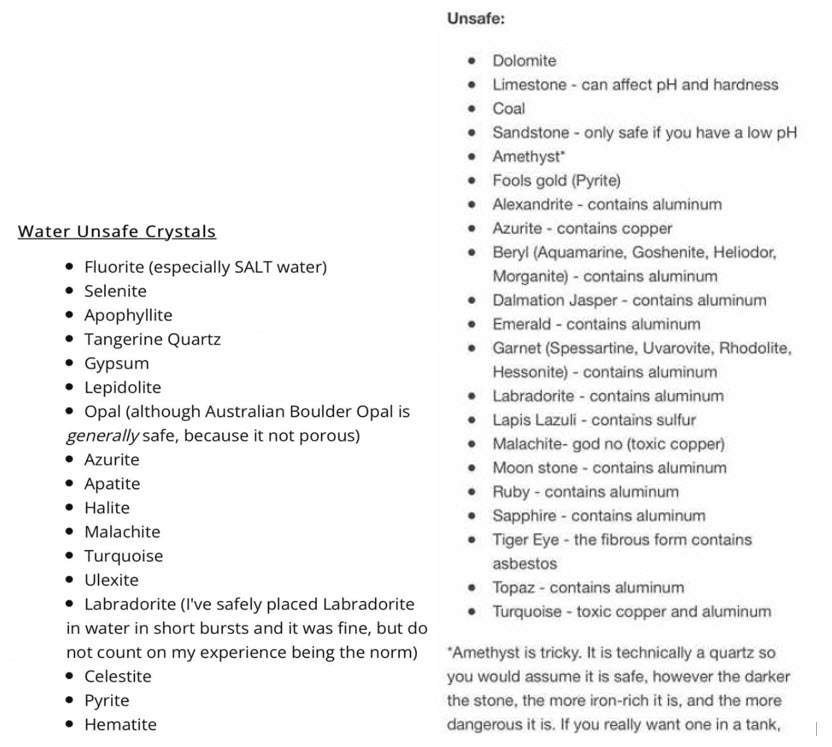
The ONLY “unsafe” minerals in these two lists are ulexite, malachite, and azurite. And these minerals are prized by mineral collectors and will certainly not be found in your local stream. These three minerals are also far too soft to be found in tumbled stones from your local gem shop.
You can grind up all the other minerals on these two lists into a fine powder and eat them. That is how incredibly safe these minerals are. Shoot, “halite” is on this list. “Halite” is just another word for table salt. Sandstone is just SAND. Yeah – SAND. The same stuff everyone uses as a substrate. And aluminum is found in almost EVERY SINGLE “ROCK” in the entire world.
An enterprising Facebook commentator looked up minerals that are dangerous if inhaled as fine dust by gem workers or miners. If extremely fine dust of virtually any mineral is inhaled into the lungs of a human there can be health issues such as silicosis. Since fish don’t have lungs and rocks aren’t extremely fine powders this is hardly a problem.
Still another site listed galena, hematite, pyrite, fluorite, selenite, celestite, iolite, turquoise, labradorite, lepidolite, mica, muscovite, talc, serpentine, moldavite, obsidian, opals, kyanite, diopside, epidote, hessonite garnet, grossular garnet, zoisite, staurolite, amazonite and lapis lazuli as minerals which will leach and damage fish.
As a degreed professional chemist with a huge mineral collection let me assure you absolutely NONE of these rocks is damaging to fish in an aquarium. NONE! All these minerals can be ground into a fine powder and eaten by a human with no effect. Galena might leach a tiny amount of lead which will reduce one’s IQ a few points but that isn’t a problem with fish.
To give you some idea of how ill informed this website is, this website says that fluorite will leach fluorine gas and kill the fish. Fluorite is calcium fluoride. The fluorine gas is extremely tightly bonded to the calcium and can no more leach out of fluorite than chlorine gas can leach out of table salt (sodium chloride). And fluorite is very insoluble.
Again, this just goes to show how much incredibly false information is out there on the web. Anyone can post anything and someone will believe them. Open websites like Wikipedia and Aquarium Wiki are especially bad.
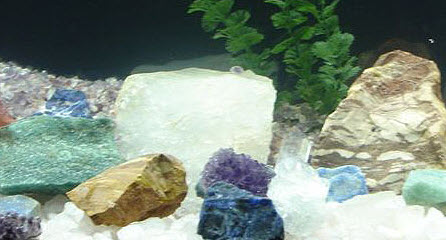
A related myth is that soft minerals will somehow dissolve in a tank.
“Just be sure not to use calcite, opal, or any “soft” stones on the MOHs scale under scaling of 7-8. (Quartz is one of the higher-rated stones.) the softer the stone is, the more likely it is to dissolve and chip or leak minerals into the water.”
So a soft rock like opal which has been sitting around for a few million years in groundwater and rain is somehow going to dissolve in the aquarium? Soft minerals like opals generally do NOT dissolve in water (opals are stored in water by gemologists!). And, oh, by the way, even if these “soft” stones could somehow dissolve in the aquarium the resulting water would be non-toxic to fish.
The mineral selenite is often listed as soluble and poisonous. Selenite has nothing to do with the poisonous element selenium. Selenite is pure calcium sulfate. Calcium sulfate is also known as “gypsum” or “Plaster of Paris”. The feeding blocks one put in a tank to feed the fish while you go on vacation are made of calcium sulfate. So, yes, selenite does slowly dissolve in water. But the result is completely harmless for fish. And calcium sulfate does not affect the pH of the water.
When breeding fish and raising juvenile fish, many breeders add calcium sulfate to the water to give the fish a good source of calcium for good bones. So selenite (calcium sulfate) is beneficial in the aquarium.
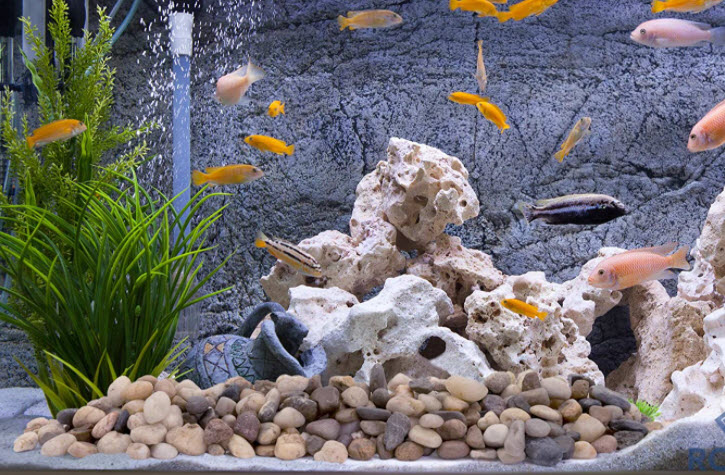
Myth #3 Lots of Gemstones and Semi-precious Stones are Poisonous
Gemstones and semi-precious stones are all very inert and non-poisonous. If they were poisonous why would one wear them around your neck as jewelry? Most of the “semi-precious” tumbled stones are quartz, which is very inert. Even the blue copper rock, chrysocolla, is largely quartz, completely impermeable and insoluble, and can’t possibly poison the aquarium.
One enterprising Facebook group administrator went to Wikipedia and looked up the composition of various gemstones (this includes “semi-precious” stones). If the gemstone said “colored by trace amounts of nickel” or something similar, she said that this gemstone would thus poison the water of an aquarium. What she failed to realize is that nickel (or other “toxin”) can’t leach out of quartz, agate, or any other gemstone. These minerals are NOT permeable. They can no more leach their coloring than coloring in a ceramic mug can leach out.
Here is a chart taken off of social media:
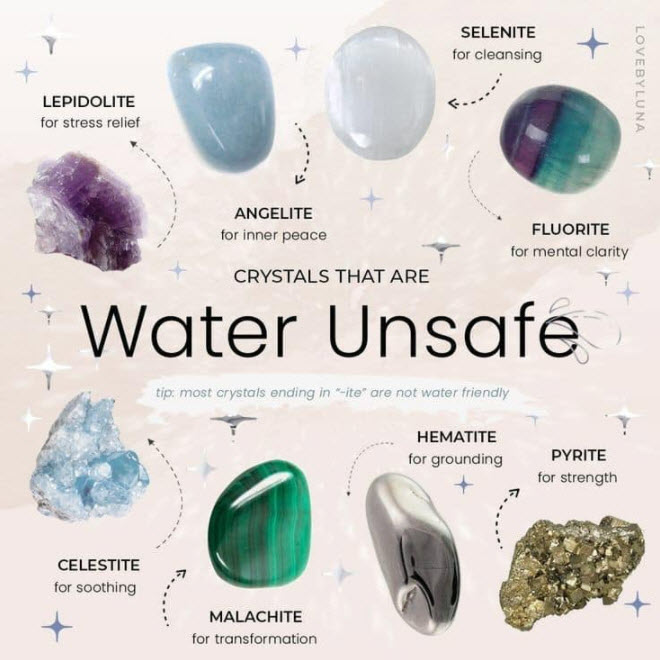
Let’s look at these minerals. Hematite, fluorite, and lepidolite are insoluble and are non-toxic even if they did dissolve, so they are completely harmless. Pyrite will slowly be acted on by certain bacteria and converted to ferrous sulfate. Ferrous sulfate is used in planted aquariums as a fertilizer and is perfectly safe.
Angelite and celestite are both strontium sulfate, which dissolves VERY slightly in water. But strontium sulfate is harmless and doesn’t affect the pH. And selenite is simply calcium sulfate, i.e. Plaster of Paris or gypsum, the same stuff that feeder blocks are made of. So, while selenite does slowly dissolve, selenite is perfectly safe. The ONLY mineral here I recommend avoiding is the malachite as it can cause a problem in some aquariums.
Still another site recommended avoiding turquoise as it is soluble in water and will kill your fish. This is incorrect. Turquoise is an extremely insoluble hydroxy phosphate mineral. It is only soluble in concentrated hydrochloric or sulfuric acids.
One website listed about 100 “toxic crystals and stones”. The site says emeralds, topaz, and turquoise are all poisonous. I’m not sure if this list is funny or just sad. All 100 crystals and stones listed are perfectly safe, even if ground up and ingested. Again, this just goes to show how much incredibly false information is out there on the web.
Then there was a person on Facebook who asked which of a bunch of tumbled semi-precious stones were OK to use in the aquarium. One of the commentators took the photo and drew a purple “X” through each tumbled stone that would “poison” the aquarium. This is the result:
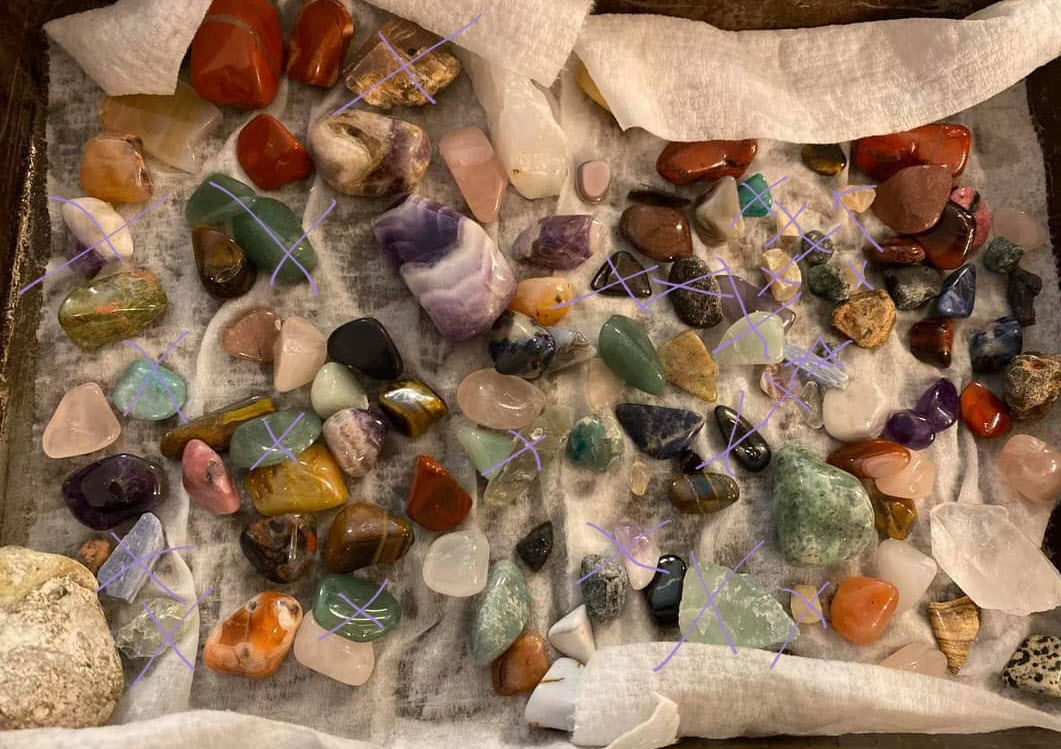
There are purple “X”s through about fifteen perfectly safe stones. This is one hobbyist who is very ill-informed (I used some other words to describe them but I was told to “play nice” by a dedicated reader).
A tumbled stone such as the stones in the picture above is tumbled in the barrel that is loaded with rocks, water, and abrasive grit. The barrel containing rocks, grit, and water is placed on a motorized machine that rotates the barrel to tumble the rocks that are inside for days or weeks at a time. As the rocks tumble, they grind against one another with particles of the abrasive grit caught between them. This action wears sharp edges off of the rocks, smooths their surfaces, and polishes them.
If a rock is soft and soluble in water it won’t last inside a tumbler. So ALL tumbled rocks are hard minerals and stones which cannot possibly poison any aquarium. The tumbled rocks are virtually all either forms of quartz (silicon dioxide) or complex alumino-silicates (feldspars, pyroxenes, and amphiboles). In any case, even if these highly insoluble materials were somehow able to dissolve in water, the resulting solution would be completely harmless.
Sometime semi-precious forms of agate (a cryptocrystalline form of quartz) are dyed purple, green, or blue. The dyes used are completely harmless to fish (typically aniline or phthalocyanine dyes). But there will be many on social media telling you these stones are deadly poison. There are NO commercially used poisonous dyes. NONE!
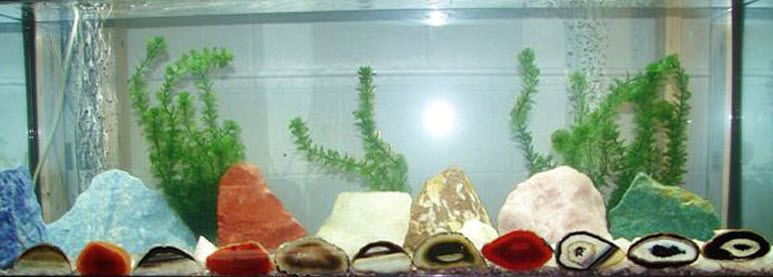
Myth #4 Crystals and Geodes are Poisonous
Most naturally occurring crystals are made from quartz. Almost all geodes are quartz. Quartz makes up about one-fourth of the rocks on the surface of the earth. It is what sand is made of. Claiming crystals or geodes leach poisonous metals is simply incorrect. Yet post a picture of crystals or a geode you want to put in your aquarium on Facebook and it is guaranteed that at least three people will tell you it can leach poisons into the water.
There is a website (thesprucepets) that goes so far as to say to avoid geodes but that quartz is safe. Geodes are made of quartz!
Still, other sites say that amethyst, agate, and rose quartz are bad while quartz is fine. Amethyst, agate, and rose quartz are types of quartz with very minor amounts of harmless impurities very firmly held inside the impermeable quartz matrix. Not only are the impurities harmless, but they also can no more leach out of the quartz than the coloring can be leached out of stained glass windows.
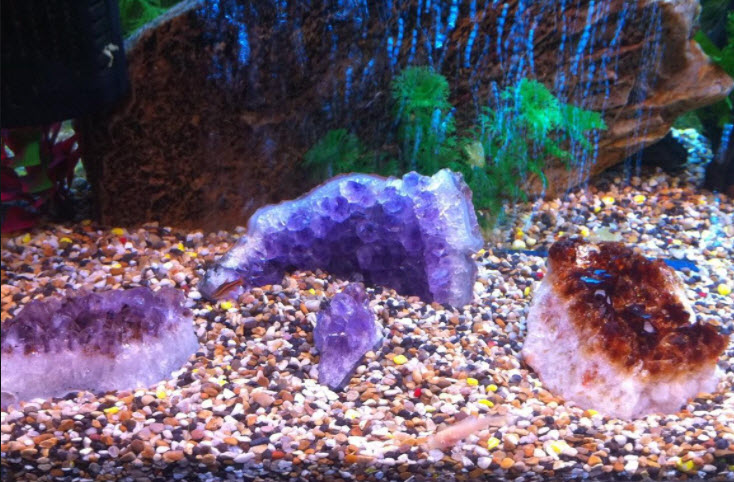
Myth #5 “Sparkles” and Iron are Poisonous
The most common form of “sparkles” in rock is the mineral mica, an insoluble silicate that is very safe in the aquarium, contrary to the many social media “experts” claiming it is poisonous. The various mineral species of mica are very common silicates and occur in most rock formations in one form or another. If mica were poisonous, no water on earth would be safe to drink.
Others claim the small particles of mica that flake off are “sharp” and will cut the fish. Cutting requires both a sharp edge and some hardness to that edge. Mica platelets are soft. They are quite slippery and form the basis of some high heat lubricants. They categorically cannot cut any fish.
Pyrite (a form of “sparkles”) is an iron sulfide and completely non-toxic. Pyrite will very very slowly decompose into soluble iron sulfate. Iron sulfate is perfectly safe with fish (the aquarium fertilizer Seachem Flourish Tabs is about 10% iron sulfate) and is removed by water changes. Iron sulfate is added as an iron fertilizer by many hobbyists with planted tanks with fish in them with no effect whatsoever on the fish. Iron sulfate is slightly acid but so little of it is added at any time from pyrite that it cannot affect pH one iota. Even if huge amounts of iron sulfate were added to the water, it would only reduce the pH by possibly half a point.
Some say to avoid any rock with orange or reddish stains on it. These stains are rust. Rust is iron oxide (actually a complex of ferric oxides and hydroxides) and insoluble in water and perfectly safe. If rocks with iron oxide stains in them were in any way poisonous no water on earth would be safe as iron oxide is a very common mineral (5% of the earth’s crust is the element iron).
And metallic iron (“steel”) is perfectly safe for fish. If you consider that the rotor of every pump motor in your tank is a cylinder of pure ferrite (magnetic iron powder sintered with strontium, barium, etc.) rotating at high speed on a steel spindle in constant contact with the water and at a temperature above the tank ambient (i.e. perfect conditions for chemical reactions) you can see that there is little need to worry about a few rust stains on rocks.
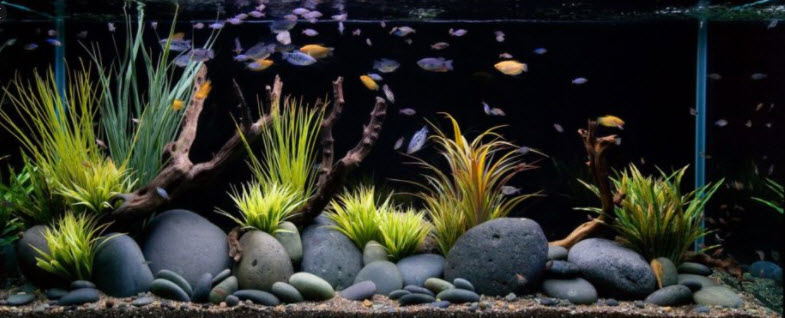
Myth #6 Heavy Metals will Leach Out and Kill Fish
No rocks will have “heavy metals which can leach out” unless you happen to be in Picher Oklahoma (a big zinc/lead mine). And even a rock filled with lead from Picher Oklahoma will only very slowly dissolve in an aquarium, possibly reducing the IQ of your fish by a few points. The levels of lead or any other heavy metal needed to kill fish are quite high.
There most certainly are no rocks or gemstones which contain heavy metals or any metals in any form which can dissolve in water. If they dissolved in water why are they still in a rock which has been soaked by groundwater and rain for several million years?
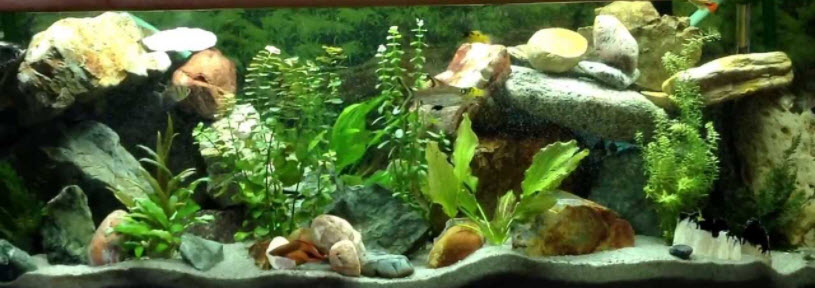
Myth #7 Metals are Poisonous in an Aquarium
I love the commentator who said to be very careful because many rocks have “veins of metal in them” and need to be avoided. If you find a bunch of rocks with veins of metal in them please message me. I’ll buy the land the rock is on, mine it, and make a fortune. “Veins of metal” are extremely rare occurrences in nature, very valuable when they are found, and aren’t poisonous when they do occur.
A related myth is that metal parts need to be avoided in the aquarium as they will decompose and kill the fish. The comment typically runs: “That ornament has metal screws which must be replaced as they will corrode and poison your fish”.
Metal screws are typically steel. Steel is elemental iron with a little carbon in it. The iron will slowly form “rust”, a mix of ferric oxides and hydroxides. This rust is insoluble and completely harmless even if it were soluble. The aquarium fertilizer Seachem Flourish Tabs is about 10% iron sulfate and harmless to fish. Iron is in no way poisonous. So steel screws are harmless in an aquarium. The ferrous form of iron is toxic to plants at levels above 50 ppm BUT in the water of an aquarium, the ferrous form of iron is oxidized to insoluble and harmless ferric forms very rapidly. So even this is not a concern.
Some screws might be brass. The amount of copper and zinc which might leach out as screws corrode is tiny. It is probably harmless to even sensitive creatures like shrimp. The only problem might be with saltwater corals in reef tanks. Now of course it is always possible to have too much of anything. I would be hesitant to put something like a piece of chicken wire made from zinc-coated (galvanized) steel in an aquarium. This might produce an overload of zinc. The same goes for brass or copper sheets or fittings in a shrimp tank.
Then some say to never put aluminum foil in an aquarium as the fish will be poisoned. Interesting. Many years ago I made some aquarium backdrops from painted aluminum foil and my fish were just fine. Aluminum in water forms tiny amounts of aluminum hydroxide which might come free as tiny particles and float around the aquarium. Aluminum hydroxide is the active ingredient in Mylanta antacid and is completely harmless to fish.

Myth #8 Sharp Rocks can Cut the Fish
There are a few types of fresh glassy lava that have edges capable of cutting a person’s hands if the edges are pressed against the hands. These rare lava’s are only found in areas with fresh eruptions so won’t be found in the aquarium.
The edges of ALL other rocks are far too dull to cut through the skin of a fish. This includes the edges of crystals and the edges of lava rock used in aquariums. If the rock is too dull to cut your hand it will be too dull to cut a fish. And note that any “cutting” action requires two things: a sharp edge and a force applied to the edge by an object like a fish. Most fish are too small to create enough force to cut themselves on even something like a knife blade put in the water.
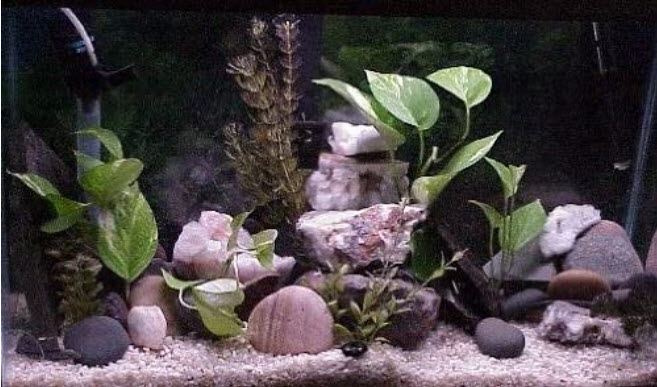
Myth #9 Insecticides and Herbicides are a Problem on Rocks
And how many people take sprayers full of insecticides and herbicides, go down to the local waterway, and spray the rocks lying around? So worrying about pesticides or herbicides on most rocks is a little over-cautious. In any case, insecticides kill insects, not fish. If one’s fish have anchor worms one treats the anchor worms by adding an insecticide to the aquarium.
While some herbicides can kill fish in high concentrations, virtually all herbicides only have lifetimes measured in days. For instance, Roundup is nontoxic to fish one day after application. So even rocks from your yard are fine if they haven’t been sprayed with herbicides in a week or so.
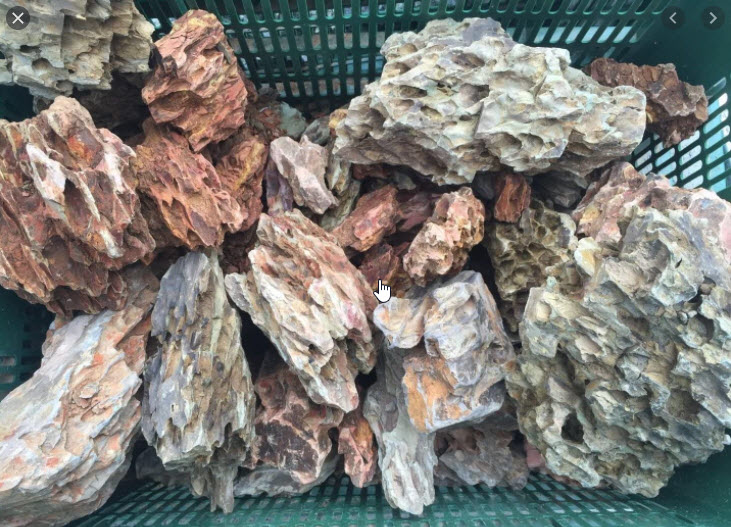
Myth #10 It is Necessary to Boil or Bleach Rocks
And why would one boil a rock or hit it with bleach? A fish or a plant added to the fish aquarium from the LFS has a million times more fish pathogens on it than any rock could have. And you can’t sterilize fish or plants.
The often heard type of refrain is “I added rocks and my fish died of internal parasites over the next two months“. There is an old saying in science “correlation is not causation”.
All the “internal parasites” that are fish pathogens (hexamita, capillaria, camallanus, fish TB, aeromonas, columnaris, etc.) are found on the majority of apparently healthy fish in most aquariums by pathologists.
So a hobbyist added some rocks and probably cleaned their filters at the same time. They created an unhealthy environment by cleaning their filters and “internal parasites” that were in the fish broke out and killed the fish. It had nothing to do with the rocks. The chances of internal parasites being on a rock from a stream are probably one in a million. The chances of internal parasites being in a fish are about 500,000 in a million. You do the math.
There is a very slim chance with any rock from a stream that it might have hydra or planaria on it. If one is concerned about hydra or planaria one could soak the rocks in hydrogen peroxide or potassium permanganate. But be aware the live plants you’re getting probably have far more hydra and planaria on them than any rock could have.
Note that many, including the author, deliberately use wet rocks (and mud!) from lakes and streams to introduce organisms into the aquarium. The greater the biodiversity in a fish tank the healthier the aquarium will be. If one strives for a sterile aquarium one will only achieve an aquarium with a lot of pathogens in it. This topic is covered in this article:
2.14. The Mature Aquarium
And a mossy rock is harmless in the aquarium. The moss will just decompose and disappear with time. If concerned just scrub it off.
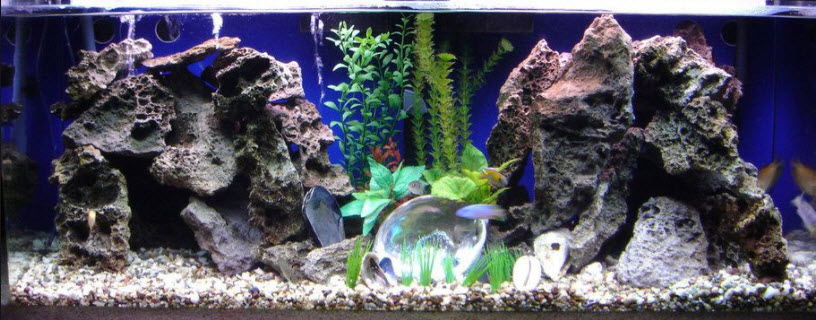
Myth #11 Boiling Rocks can Explode
There is no reason to boil a rock but some people will do it. They will then be told on social media: “That boiled rock could have exploded and killed you“. This simply cannot happen. It would violate at least three basic laws of physics for any rock to explode while being boiled. It is impossible.
There are a bunch of people on social media who have noticed that rocks in a fire pit explode. Yes! rocks in a fire pit often explode. It is quite common. The science behind these explosions is very well understood (they are high-temperature and high-pressure steam “explosions”). But there is a HUGE difference between a campfire and a pot of boiling water. A rock in a pot of water brought to a boil simply cannot explode. The science behind this is quite firm.
Think of it this way. The reason a rock would explode is because of water inside it rapidly expands and turns into steam. But keeping water under pressure such as it is inside a rock raises the temperature required for the water to turn to steam (basic law of thermodynamics!). Outside a rock, water takes 212 degrees before turning into steam. Inside a rock, it takes 500 to 1,000 degrees for water to turn to steam.
A campfire can raise the temperature inside a rock to 500 to 1,000 degrees and the rock can “explode” due to the formation of a rapidly expanding steam pocket. Note that in actuality the rock normally just splits into two pieces with a loud bang, the two pieces ending up inches from each other, hardly a hugely dangerous situation.
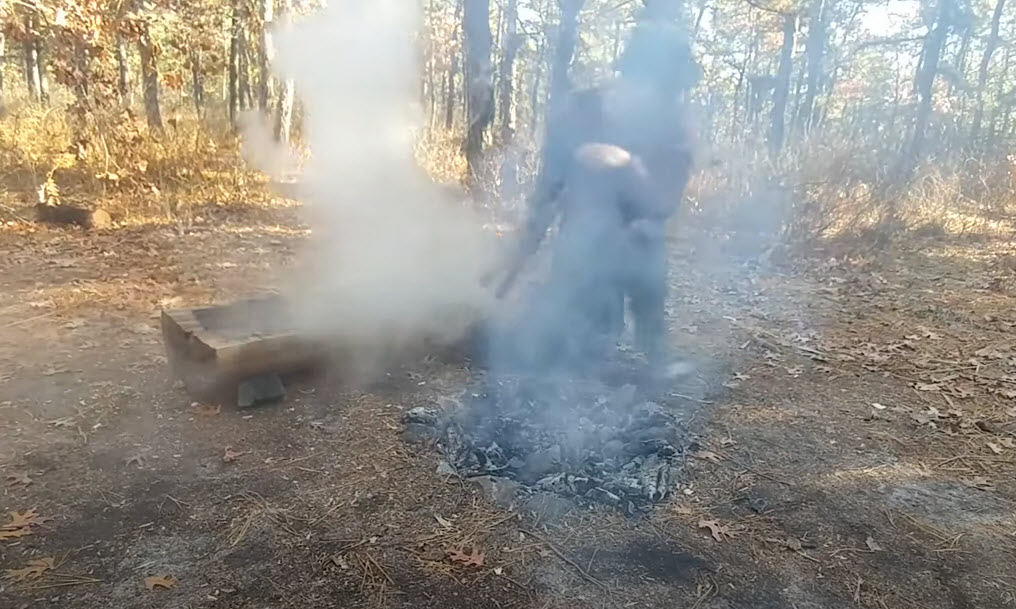
It is impossible for the water surrounding the rock in a boiling pot to exceed 212 degrees, the temperature of the boiling water (via a basic law of thermodynamics). So the temperature inside the rock cannot possibly exceed 212 degrees. So steam inside the rock in a pot of boiling water is impossible. And an explosion in a pot of boiling water is impossible.
Note that rock with air in it, such as pumice, does not explode when heated. The common refrain is that if you boil a rock, there can be air pockets inside the rock that “explode”. Can’t happen!
The air pressure created by even 1000 degrees is insufficient to blow up rock, per another law of physics, namely the ideal gas law, or Boyles Law, PV=nRT. The temperature of boiling water, namely 212 degrees, certainly can’t cause an “air explosion”. The air inside the pumice will go from 14.6 psi at 70 degrees to roughly 17 psi at 212 degrees. 17 psi minus 14.6 psi = 2.4 psi. A pressure of only 2.4 psi will not cause anything to explode. When you blow out a candle you create more than 2.4 psi of air pressure.
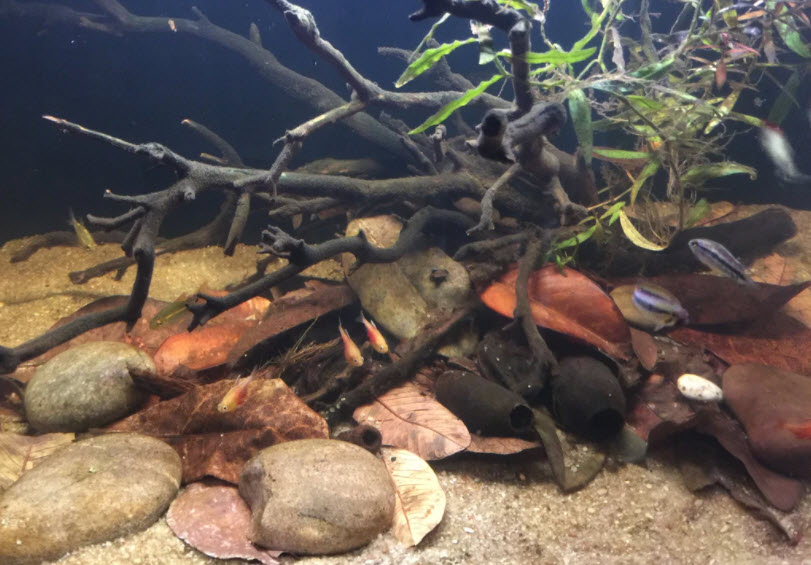
Now that being said if one has a pot of boiling water and one drops a rock into the boiling water, the rock can theoretically loudly “crack” and break apart due to differential thermal expansion. The outside of the rock quickly expanded while the inside of the rock did not expand. But this “crack”, simply a loud noise, will hardly be sufficient to “break a window next to the stove” or “kill you”. Note that thermodynamic energy considerations say this cannot happen in real life, the temperature difference between room temperature and 212 degrees is too small. But we’ll mention it as a very remote “possibility”.
When anyone asks about boiling rocks on social media at least twenty individuals come up and say “never boil rocks because they explode“. When asked for some proof that this happens they typically don’t respond. A few responded with a YouTube video of someone with a campfire and a bucket of water. The person takes out a very hot stone from the fire and places it into the water (probably a 600 to 800-degree temperature differential). And the stone breaks apart with a very small “explosion” of water.
This is due to differential thermal expansion (i.e. “thermal shock”) and has nothing at all to do with putting a rock into a pot of water and boiling it. It “proves” nothing. There is a HUGE difference between heating a rock in a fire pit and heating a rock in a pot of water.
There is even a website that says boiled rocks can explode! howtofindrocks.com says the following:
“History knows when the rock explodes being boiled. That means that such a low temperature like 100°C (212°F) can be enough to blow up the rock. Sometimes people place rocks into boiling water to disinfect the rock. But it is extremely dangerous as the rock can pop up and explode.”
You can find anything on the web if you hunt hard enough. That doesn’t make it accurate.
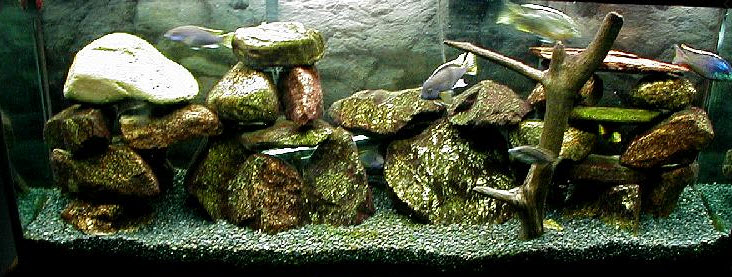
Myth #12 Sandstone will Fall Apart in the Aquarium
Many folks have heard that one needs to be careful with some rocks like sandstone and shale because they will fall apart in the water of an aquarium and become sand. Interesting! Let me get this straight, a rock that has been exposed to groundwater and rain for at least several thousand years is going to fall apart in a short time in the aquarium.
There is a material called “mudstone” which is just dried hardened clay. This will fall apart in the aquarium. But it won’t be found in the open due simply to the fact it will disintegrate in rain. One has to dig this “stone” out of the earth.
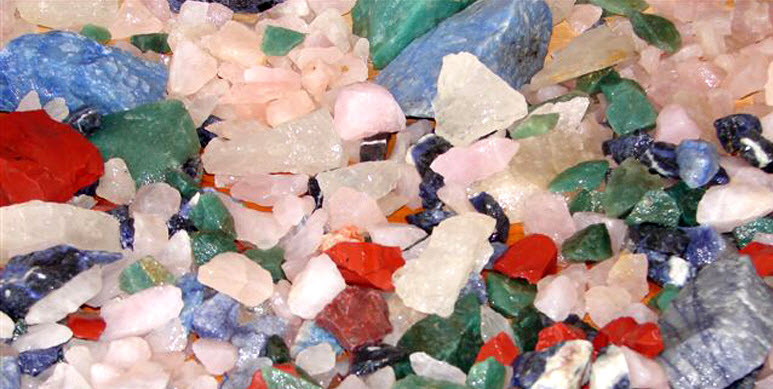
Myth #13 Porous Rocks Must be Cleaned with Detergents
This is probably the most dangerous myth. One commentator said that porous rocks will absorb toxins from the environment and need to be thoroughly cleaned with dishwashing detergent before being added to an aquarium. Three points:
- What toxins? The last time I checked my local rattlesnake population was not going around spraying their venom on the local rocks. And the insecticide/herbicide “problem” doesn’t exist (see above).
- Detergents make oil and water mix. Toxins from nature aren’t oils. So why clean with detergents?
- Detergents destroy the lipids in the cell membranes of the gills of the fish. So detergents are poisonous to fish.
So you’re going to clean rocks which have virtually zero chance of having a fish toxin on them with a known fish toxin. This doesn’t make a lot of sense.

Myth #14 Green Rocks are Dangerous
While copper minerals are uncommon there are a surprising number of small copper ore pockets scattered here and there across the US that typically have been mined out. In the tailings of such small mines one will find rocks colored green by small amounts of copper silicate minerals. These green rocks are harmless.
If you find a green rock anywhere but in the vicinity of a copper mine, the rock can be colored by any one of many common green silicate minerals. These include peridotite, actinolite, serpentine, olivine, chlorite, glauconite, and pyroxene. These common green silicates are completely harmless.
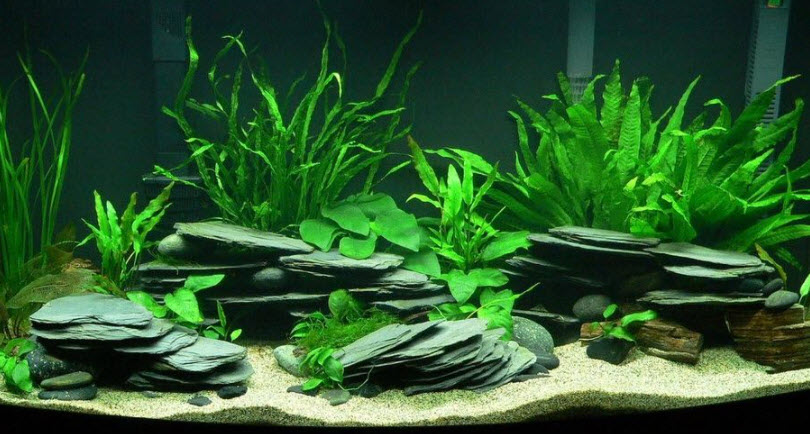
Myth #15 Shales Need to Be Avoided
This narrative proceeds along the line of “some shales are filled with oil and can poison your fish with petroleum residues“. Interesting. First off oil shales are very rarely found near the surface (in the United States this is limited to Southwest Wyoming). Secondly, oil shales near the surface will have evaporated all the oil residue from themselves thousands of years ago. So even if you are in the oil shale regions of Wyoming the oil shale rocks you might find are harmless.
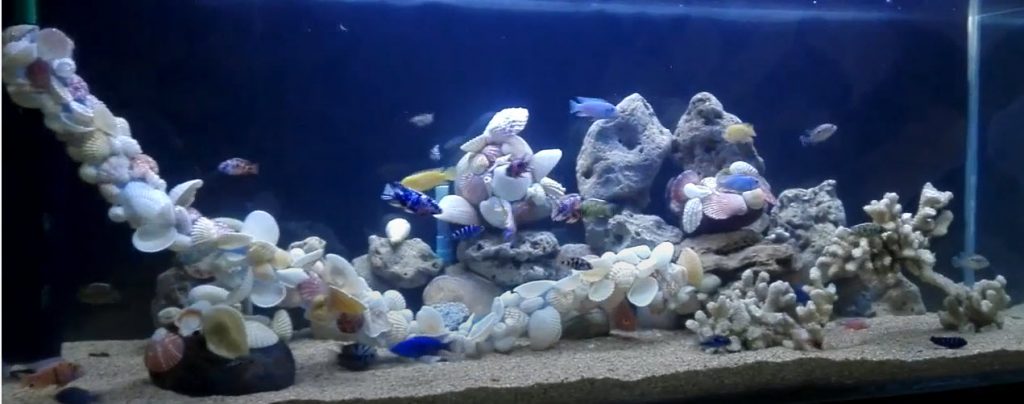
Myth #16 Shells Need to be Coated
Shells and coral are typically about 98% pure calcium carbonate, the same thing as limestone. Indeed, most limestone is just shells and coral that have been buried in the earth and “metamorphosized” into rock. So the dissolution rate of shells and coral is extremely slow and only very tiny amounts dissolve to get to the 7.6 to 7.9 pH equilibrium. So shells or coral do not need to be sealed in lacquer or epoxy in the aquarium. They will last for many years in most aquariums.
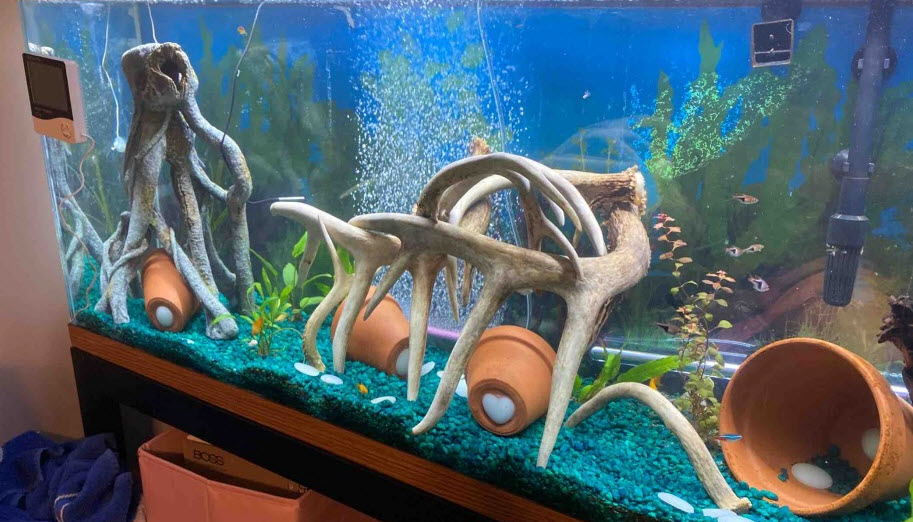
Myth # 17 Bone and Antlers will Decompose if not Coated
An animal skull is a type of bone, a composite material consisting of both inorganic and organic components. The inorganic component is primarily crystalline hydroxyapatite: [Ca3(PO4)2]3Ca(OH)2. This apatite is a VERY insoluble material. The organic component of bone comprises more than 30 proteins with type I collagen being the most abundant (>90%). By dry weight, the inorganic apatite constituent accounts for about 67% of the tissue while the organic protein component makes up approximately 33%.
The protein in fresh bone CAN decompose relatively rapidly in the aquarium and CAN create water quality issues, sealed or unsealed. I’ve never seen a problem but remember, my tanks are all very over-filtered so decomposing proteins will be rapidly converted to harmless nitrates. In theory, a new filter or a filter with poor media could have a problem with new bone. Old aged bone is just insoluble apatite and can last for many years in an aquarium without any coating.
Antlers are also “bone” but have a slightly higher organic protein content (40% to 50% by dry weight). Antlers can thus decompose a little faster in an aquarium than can a skull. But aged antlers will still rarely create a problem in an aquarium and will still last almost as long as a skull.
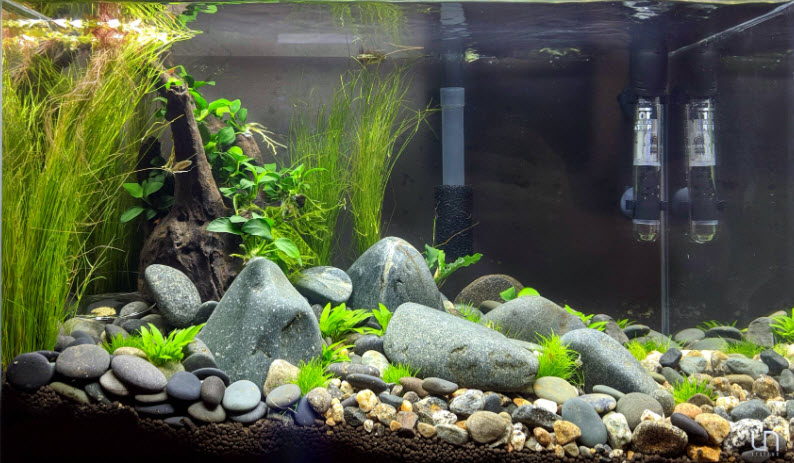
Myth #18 Be Careful of Radioactive Rocks
“There are radioactive rocks which can kill your fish“. Someone came up with this well intentioned but ill-informed claim on Facebook. The only decently radioactive mineral one might very rarely come across is a very rare yellow crumbly mineral called “carnotite”. It is an oxide of largely uranium.
The uranium image has suffered from its association with the first atomic bombs. Its reputation as a malevolent radioisotope, however, is undeserved: in fact, the decay rate of uranium is among the slowest known to man. The half-life of uranium is of 4.5 billion years, which means it has VERY low radioactivity. The activity of a sample of uranium could be compared to the water flow escaping from a large lake through a pinprick.
Contrary to the widespread fears, even pure uranium presents low risks owing to its very low radioactivity. Its radioactive toxicity, according to experts from the Nuclear Regulatory Commission, is a hundred times weaker than its chemical toxicity, which itself is no different from the chemical danger posed by common heavy elements such as lead.
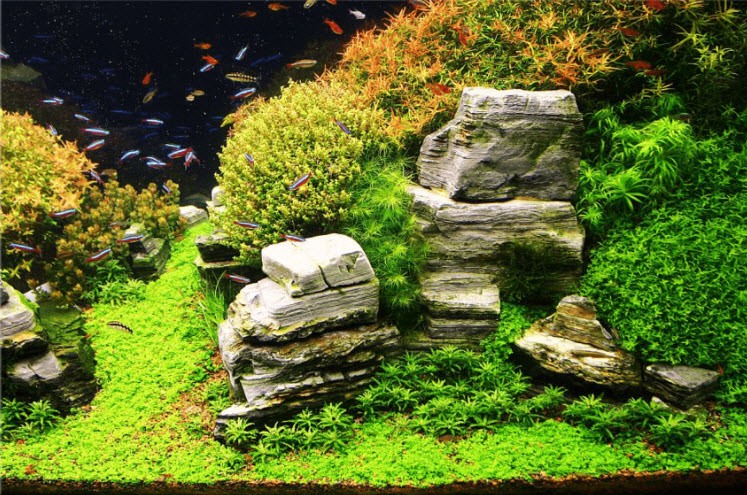
Myth #19 Rocks from the Seashore Contain too Much Salt
The amount of salt found on seashore rocks or coral is minute and harmless. Salt is very soluble, so one won’t have large crystals of salt sitting inside a piece of coral or rock. And note many ascribe to adding salt to a tropical fish tank as a tonic, a harmless practice.
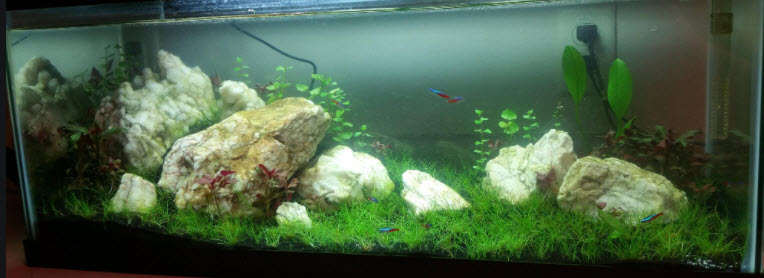
Myth #20 Avoid High Silica Rocks like Quartz to Prevent Brown Algae
A type of algae (“brown algae”) called “diatoms” requires silica to form their shells. Supposedly, according to this myth, rocks with silica in them cause brown algae outbreaks in the aquarium. First off virtually all tap water has 5 to 15 parts silica in it. At roughly 10 ppm silica comes to equilibrium at room temperature. Silica forms 90% of the composition of the surface of the earth so getting water without some silica in it is virtually impossible. And it takes some time for silica to dissolve out of even fine sand.
The surface area of rocks is very low compared to the surface area of other silica sources such as sand or gravel. There are NO aquarium substrates that do not have silica in them. So if one has RO water, distilled water, or rainwater the substrate will raise the silica level thousands of times faster than any rock possibly can. If one has a glass aquarium, the amorphous forms of silica found in glass will dissolve much faster than the forms of silica found in rocks.
But in truth neither substrates nor the glass of the aquarium add significant silica to an aquarium. Even distilled water on a fine quarts sand substrate will dissolve only in the parts per billion per week. Silica and silicates are just far too insoluble at the temperatures and pressures encountered in an aquarium. They need years of contact at very high pressures and temperatures for substantial amounts to dissolve.
And finally, “brown algae” is not always diatoms. It is often a whole host of other organisms which will form even in silica-free water. Brown algae is a natural and unavoidable part of the ecology system in any aquarium. One should just learn to live with it.
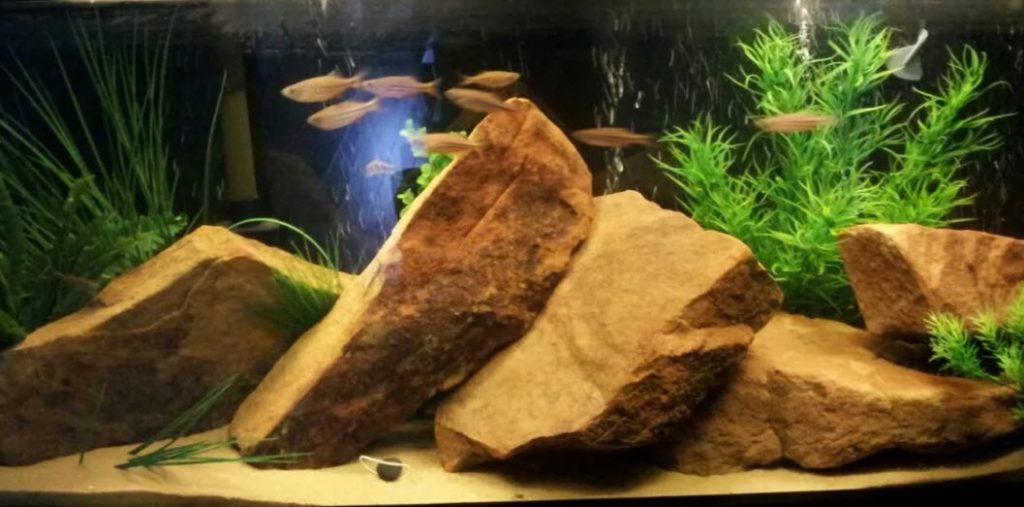
Myth #21 Pathogenic Protists will be Found on Sedimentary Rocks
One YouTube presenter has a video where he says to avoid all sedimentary rock as it is porous and will have all sorts of bad “protists” on it like single-celled algae and protozoans. And according to this well-meaning but incorrect individual, the porous rock must be avoided because it will harbor “little protists that you don’t know“. Yes, the porous rock will harbor all sorts of “protists that you do not know“. But they are ALL beneficial to the ecology of the aquarium. And in any case, unless the rock was found in the water the protists one might find will probably die submerged in water.
It is very difficult for people to understand that virtually every little single-celled organisms you find in nature, all the little “protists”, are beneficial in the aquarium. The more little types of “protists” one have in the aquarium the better the ecology of the aquarium will be. Even the bacteria one finds on sedimentary rocks in nature will be beneficial in an aquarium. Fish pathogens come in on the fish, not on the rocks. Note that the definition of the term “protist” is somewhat vague and constantly changing, but generally means single-celled algae, amoebas, and ciliates (such as paramecium).
Note that many, including the author, deliberately use wet rocks (and mud!) from lakes and streams to introduce organisms into the aquarium. The greater the biodiversity in a fish tank the healthier the aquarium will be. If one strives for a sterile aquarium one will only achieve an aquarium with a lot of pathogens in it. This topic is covered in this article:
2.14. The Mature Aquarium
This video maker also goes on and on about how one should avoid green rocks like serpentine as they might contain copper. Unless the green rock is found near a copper mine it will NOT contain copper. There probably isn’t a serpentine rock in the entire world that contains copper. The green color in serpentine is due to green amphiboles, and not due to copper. And even if the rock did contain copper it will not be in any form which can leech out and kill something like snails or shrimp.
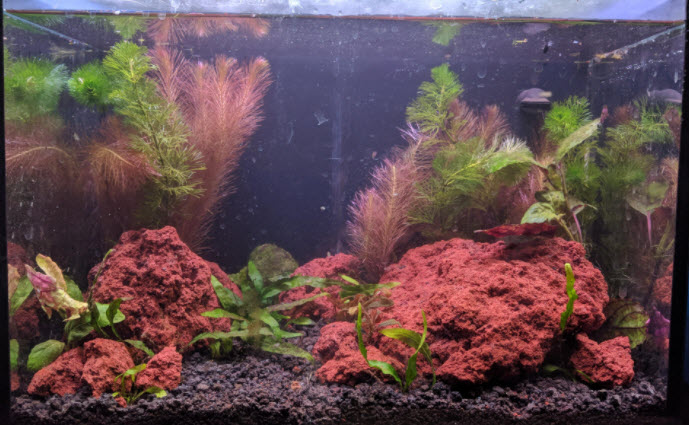
Myth #22 Lava Rock is Bad As It can Contain Sulfides and Carbonates
Another commentator, a “degreed geologist” warned that lava rock can have “poisonous” sulfides like pyrite in the matrix. Yes, maybe one in a thousand lava flows have significant amounts of pyrite (iron sulfide) embedded in the silicate mineral matrix. But pyrite is NOT POISONOUS (see discussion above) and only dissolves very slowly when acted on by certain bacteria. Other metallic sulfides such as cinnabar do not occur in lava flows and are not poisonous if they were found.
This same geologist warned that lava rock can leach carbonates which will change the pH of the water. There is one volcano in the world (in Tanzania) flowing with carbonate lava. Because carbonate lava typically is largely sodium carbonate (baking soda) it rather quickly dissolves in most environments. And I very much doubt if the lava from Home Depot is from Tanzania. In any case, carbonate is beneficial to the aquarium, not bad for it (see above discussion). Sooooo….what?
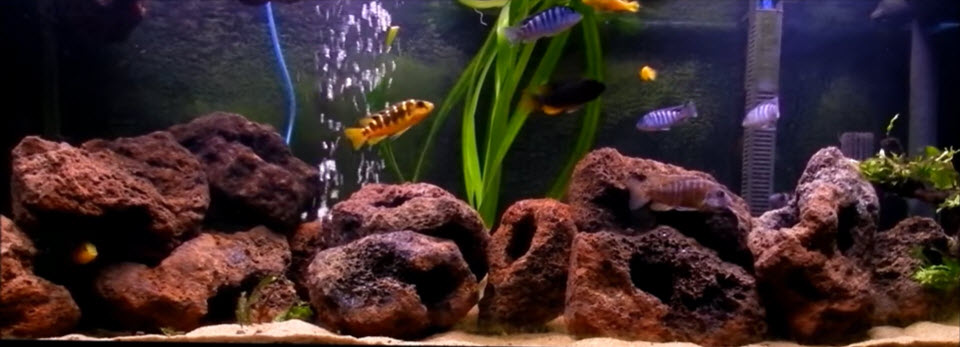
Myth #23 Fresh Lava is Poisonous
This comment came up on social media: “Lava rock is only suitable for aquariums once it has been weathered and cleaned. When fresh it is quite poisonous“. Lava is simply molten rock. It is a complex mixture of aluminosilicates that can no more poison a fish than any other rock can poison a fish. It simply is impossible. I asked the person who made this comment “what exactly were the poisons that the comment was referring to?”. I did not get an answer. ALL lava rock, even “fresh”, is just fine in the aquarium.

Myth #24 Lava Rock Decomposes Nitrate
There are websites (aquaessentials.co.uk and Aquariumfish.net) that claim the following about lava rock in an aquarium:
“You only have to inspect the rock and you can see it is covered in tiny holes making it extremely porous allowing water to pass through and diffuse into the rock. So what do The Hidden Benefits of Lava Rock mean? An anaerobic environment is created inside the rock as beneficial nitrifying bacteria consume all the oxygen in the water. Within this anaerobic environment inside the rock, denitrifying bacteria consume the nitrate and produce oxygen and nitrogen. We all know how nitrate in the aquarium is bad news for fish and shrimp so Lava rock is the most natural and best way of removing nitrate.”
I can’t sugarcoat it. This statement is pure and simple marketing hype, i.e. pure snake oil hogwash. Here are some lengthy articles which go into the myriad of reasons this is hogwash.
14.2.4. Anaerobic Substrates
7.5. Denitrifying Filter Media
Note that the term “lava rock” in this quote is linked to a website that sells lava rock. Click on the link, buy some lava rock and the website gets a commission. Don’t you just love the profit motive?
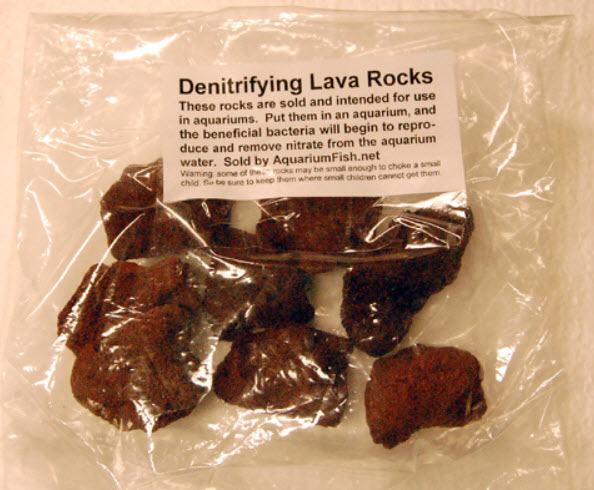
Again, let me emphasize, that lava rock categorically does absolutely NO removal of nitrates to nitrogen gas. It is completely impossible.
Myth #25 Cleaning Chemicals on Rocks
Another well meaning but ill informed commentator said that dry cleaners dump their used dry cleaning chemicals on the ground, thus contaminating rocks. ALL the various chemicals used for dry cleaning (various chlorinated carbon compounds) will rapidly evaporate from any exposed rocks. And, since the chemicals used by dry cleaners cost a lot of money, they DO NOT intentionally pour them out. After a certain number of uses the chemicals are cleaned up and recycled by distillation.
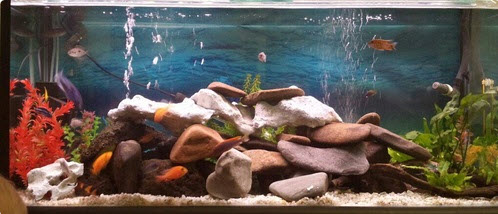
Rocks in an Aquarium
Belief Perseverance Effect
Note that the author is a degreed professional chemist and research scientist with a mineral collection of well over 1,000 specimens. When this fact is posted together with the above analysis you would be amazed at how many people say that the author is dead wrong and does not know what he is talking about when it comes to rocks. One lady called the author an idiot.
This is the psychological phenomenon of the “belief perseverance effect”. Even when presented with the science, people will rationalize and rationalize to uphold a belief they have held for a long time. We don’t even try to fight this phenomenon.
.
“Nothing dies harder than a lie that people want to believe” Calvin
.
For our aquariums, we just clean the rock of any loose soil or debris and then add it to the aquarium.
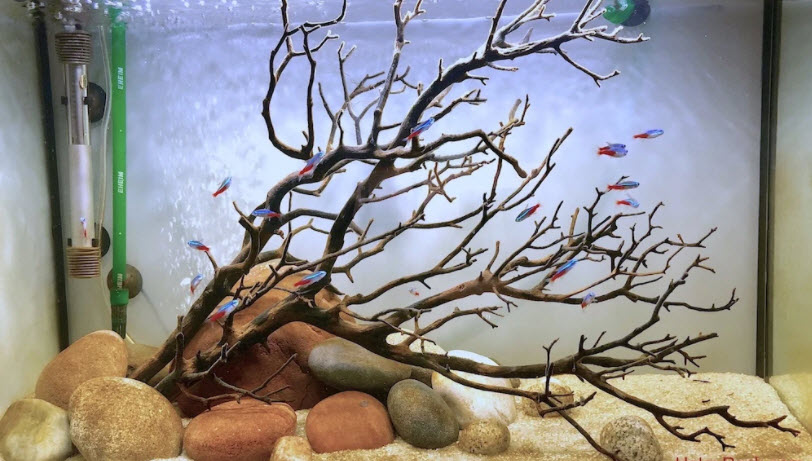
Wood
Many come on social media and ask things like “can I use wood and rocks found in my yard in my aquarium”. Wood, just like rocks, has all sorts of myths parroted about it. The truth about wood can be found in the link:
14.10. Wood In the Aquarium
.
Return to Equipment Menu
.
Aquarium Science Website
The chapters shown below or on the right side in maroon lead to close to 400 articles on all aspects of keeping a freshwater aquarium. These articles have NO links to profit-making sites and are thus unbiased in their recommendations, unlike all the for-profit sites you will find with Google. Bookmark and browse!
.

Dave says
In reply to Dan ….. No the fish won’t be harmed by eating periphyton all day long.
Dan says
Hi Dave, thanks for the article! After reading and rereading several times, I decided to grab a rock out of a river and stick it in my tank today. It had some brown algae on it. Well my danios and lone kuhli loach absolutely loved it. All of them grazed it basically nonstop throughout the day, and the kuhli, who ordinarily hides quite a bit, has plopped himself right on top of it and made it his new hangout spot.
My question: does the gorging that the fish did throughout the day today amount to overfeeding?
This is a three month old ten gallon tank with a hang on back filter and a week-old under gravel filter. Thanks! Love your site!
Mik says
Hi again, I love reading and rereading your site. Most of your information is in regards to freshwater tanks and while I have 13 of those, I just set up a reef aquarium. It’s amazing how no one wants to use filter media and they just use “live rock” and explain that it has holes so it is a great filter and dentrifier. I don’t even bother engaging on that point.
At any rate, I am putting together a sump and, in addition to my filter foam, I wish to use lava rock. Not for filtration as it is pretty ineffective, but for an area for copepods and detrivores to collect and breed in the refugium before the return pump. Fairly common in the marine realm, but everyone uses expensive “live rock” for this because lava rock will leach out heavy metals especially iron because it’s red. I cannot logically fathom this would be true in a ph8 world of Reef sump when it’s not true in a freshwater simp. Am I off base, or are lava rocks still OK for marine tanks?
Thanks as always, have a great day!
Diane says
WOW! Thank you so much for all of the detailed correct information on what I can be assured of, will not harm my fish. With most of the glorious minerals of the world that make me so happy, now I can decorate my tanks with limitless possibilities. Who knows, the fish may gravitate to their favorite ones. I appreciate all of your hard work preparing this article, now my choices are endless with the exception of very few.
Patrick says
Wow, thanks for such a detailed write-up. I’m looking for some blue rocks to put into my aquarium and was thinking of blue agate or lapis lazuli. Cursory Googling suggests lapis lazuli is quite poisonous for fish because it leaches sulfur, but you say that lapis is safe and sulfur is not poisonous. This is fantastic information to have!
Dave says
In reply to Jonathan ….. Yes. you make a valid point. I wouldn’t use any copper based fittings with cherry shrimp.
Jonathan says
Hi, David!
I’ve been referencing your website for several years with excellent results. So thank you for continuing to add to it. Regarding your discussion of metals in the aquarium: I have recently started using various metal tube fittings to help run rigid tubing from an internal powerhead to an external fluidized bed filter. However, after putting it together I realized a number of the fittings are composed of nickel plated copper or nickel plated brass. My aquarium contains breeding cherry shrimp, and I am wondering if, for the safety of my shrimplets, I need to replace those fittings with fittings that do not contain brass or copper.
Thank you for making the outstanding information on your website publicly available!
Dave says
in reply to Kelsey …… Lepidolite is a lithium aluminum mica which is completely insoluble. It cannot leach anything into the water nor can it change either the pH or the hardness of the water.
kelsey says
Ok I feel silly asking now that I’ve read the article but I was told that Lepidolite has lithium and aluminum in it which is toxic to the fish. Is there really no risk of it “leeching”? I’ve also read Lepidolite is really soft so that’s the only reason I thought it might be possible.
if that’s not true would it drastically alter the PH of the water?
I already have hard water where I live so that’s my main consideration.
Dave says
In reply to David …. I put a teaspoon of dark brown detritus from a pond into a sock (the type that go on your feet). I then wet it, tie a knot in it and leave it in the aquarium where a goodly flow of water goes across it. The water will get cloudy but it clears in a few weeks to crystal clear.
DAVID R FLICK says
When u say u use wet rocks and mud from outside, doesn’t the mud cloud the water? How do u introduce mud in ur aquarium
Kita says
Thankyou for this, I’ve got some beautiful ironstone and set them up today on top of each other and my fish especially my clown fish are loving it. Thankful it’s ok to have in my tank now after reading. I’ve seen all those comments in pages and was worried.
Sam says
Thank you so much for clearing these things up. I got some slate rock online and was too scared to put it in with my axolotl due to thinking the metallic inclusions in the rock might be poisonous for them. Now my only concern is them cutting themselves on sharp edges on the slate cause they do get a little rambunctious from time to time though I doubt that’s anything to worry about..
Ray says
Thank you for writing this article! I’ve been wondering if what applies to fish aquarium here would also apply to reptile tanks? The main difference is there’s probably more heat in a reptile tank than a fish tank.
Also I couldn’t find anything online on Phosphosiderite. Is it also safe as well?
ggggg says
May i thank you for my concerns on Myth#8 sharp edges cutting fishes.
I was concerned about this so much and googled it alot. Most people seemed to agree on sharp stones being dangerous. But your analogy makes total sense. Even if i grab a stone with all my strength it wont cut my fingers. Fish’s force is 1/100000 of that. No way it will harm itself!!
Andrew says
Thank you so much…I was freaking out that I’d just spent a bunch of money on lapis lazuli and sodalite for my tank…absolutely loved the way it looked and was so bummed out that I might have made for a toxic nightmare. I was ready to complain to Amazon and request a refund since I couldn’t really return mixed stones from a bunch of sources…but I’m going to put these back in with a much lighter heart. Thank you!!
Anonymous says
Love this article! Thank you for taking the time to address all these “issues”
jessie says
hi Dave i ran across your site looking if i can use my rock collection to scape my tank, my shrimp are enjoying the amethyst lol.
the google search for “amethyst in aquarium” comes up with a snip from your sight. the clipping they took is the myth #2s first sentence “Aquarium Wiki website says to avoid; limestone, coral, amethyst, geodes, gypsum, ironstone, nephrite, marble, jasper types, sandstone, and feldspar as they are poisonous.” i got a good laugh out of it.
Voxx6 says
Re: Dave
Thank you so mich for the response, I can’t remember the last time someone responded back to a comment on a site such as yours, or even to emails when they insist to reach out…etcetc. I came here, to this site by chance, thinking “sure, I’ll read another blog/article/”research paper”, and get absolutely no where with my curiosities”, but I was quite excited once I started reading, I went through so many of your topics. Some new info, some refreshers and some just interesting to read when I don’t want to doom scroll political news. I have this bookmarked and I’m going to hope you have one of those “support” or “buy me a cup of coffee” link so I can support such a fantastic source of info from someone who continually takes the time to respond to site visitors. You wouldn’t by chance know anything about Wertheimeria Maculata? Not much info on these guys out there, maybe I hit jackpot here lol. Have a good one.
Voxxy
Dave says
In reply to Voxxy …. Perfectly safe. It is largely quartz with some green amphiboles and pyroxenes (both complex alumino-silicates), probably originating in the same way granite originates (igneous intrusions)
Voxxy says
Would Kambaba jasper (which I know isn’t a real jasper) be safe?